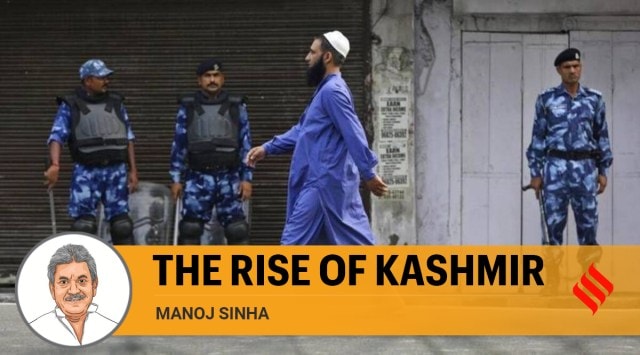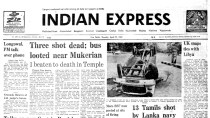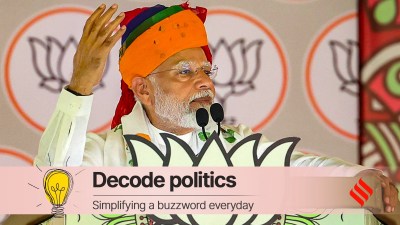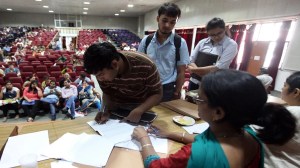- India
- International
The rise of Kashmir
Manoj Sinha writes: Three years after break from past, it is moving forward, becoming destination for tourists and businesses
 The security situation in the UT has undergone a sea change for the better. What was considered unachievable three years ago has been accomplished. Stone pelting and strikes have become a thing of the past.
The security situation in the UT has undergone a sea change for the better. What was considered unachievable three years ago has been accomplished. Stone pelting and strikes have become a thing of the past.Ideas and actions rarely get wind together to end decades-old social inequities. Visions can become virtues if they are accompanied by a determination to create an equitable society. Three years ago, Prime Minister Narendra Modi decided to offload the past that was holding back the 1.3 crore citizens of Jammu and Kashmir from realising their potential. He rolled out the process to build a new and vibrant Union Territory. He urged people not to lose even a single moment in the new journey of challenges and opportunities and promised to reach out to the last person in the last row. Jammu and Kashmir, since then, is walking the PM’s talk and has travelled quite a distance to re-arrange priorities of development, initiate deep reforms in governance, curb corruption, neutralise a well-fed terror ecosystem and realise the dreams of youth. Jammu and Kashmir can no longer be seen as a land of misconceived ambitions. In this Amrit Kaal, we are the new destination, not just for tourists but for businesses as well.
A series of targeted efforts to tide over governance bottlenecks, financial indiscipline and lack of monitoring has yielded results in the form of developmental projects. In 2018-19, only 9,229 projects were completed in a year. This has increased to 50,627 in the financial year 2021-22. Our effort is to ensure that Jammu and Kashmir is at par with the other states and UTs in most of the indicators. Rs 1 lakh crore is being spent to improve road connectivity and build tunnels, and we are determined to fill the resource gap in the creation of new infrastructure. Social sector spending has increased by 43.83 per cent and the economic sector by 45.60 per cent in the last three years. It shows the importance the Centre has attached to the overall development of Jammu and Kashmir. We have taken a slew of measures for improving the delivery of public services and prudent financial management. Implementation of the Janbhagidari Empowerment portal demonstrates the administration’s will to empower people through an initiative that enables them to oversee the works being executed and money spent in their area. It encourages them to become a partner in the development process. We have harnessed the power of information technology to eliminate red tape and enhance transparency. J&K was ranked first amongst the UTs in the recently released National e-Governance Service Delivery Assessment Report. More than 200 public services have been made available online to receive real-time feedback from citizens. Providing houses to people in rural areas, developing roads, putting in place primary health facilities and safe drinking water services, creating more avenues for education, employment, and agriculture, attracting private investment and bridging gaps between government delivery mechanisms and people’s expectations were some of the tasks we completed by building trust between the administration and the people.
Structural and institutional changes like ending the 150-year-old Darbar Move brought in another layer of transparency and improvement in governance. It also saved about Rs 400 crore annual expenditure that used to be incurred in shifting logistics from Srinagar to Jammu and back. It has also prevented the loss of at least one working month every year. We have adopted zero tolerance for corruption and more than 639 cases were registered against UT employees in the last two years.
The intelligentsia and PRIs were called upon to collectively rise to the task ahead in terms of strengthening agriculture, horticulture, planning projects for rural Jammu and Kashmir, unemployment and getting rid of inertia in governance. The thrust of the initiatives was to strengthen grass roots institutions and make villages the growth engine of the UT.
The security situation in the UT has undergone a sea change for the better. What was considered unachievable three years ago has been accomplished. Stone pelting and strikes have become a thing of the past. Strict action is being taken against troublemakers, instigators and agent provocateurs through legal measures. No civilian casualty occurred while managing the law and order situation in the last three years. For that, I have to thank the J&K police and the larger security establishment. The net result is the record footfall of tourists — one crore tourists visited the UT during the last seven months (January to July).

Jammu and Kashmir is trying to scale up infrastructure. Projects worth Rs 58,477 crore under the Prime Minister’s Development Package have picked up pace and direction after impediments and bottlenecks that hindered growth — land acquisition, forest clearances, utility shifting and court cases — were removed. Fifty new degree colleges have been established increasing the number of seats by 25,000. Big ticket infrastructure projects have come in the healthcare sector. Two new AIIMS, seven new medical colleges, two cancer institutes and 15 nursing colleges have been added and 140 health institutions are being upgraded. An additional 41,141 km of roads have been constructed. J&K is placed 4th in the ranking of states and UTs based on their performance in the Pradhan Mantri Gram Sadak Yojana.
Despite having a hydropower potential of 20,000 MW, J&K could tap only 3,500 MW in 70 years. In the last two years, projects for about 3,000 MW were revived. Earlier, J&K had shied away from agrarian change. With sustained interventions, the UT has achieved the third rank in the monthly income of agriculture households and was ranked the fifth best performing state/UT in agriculture and allied sectors. Thirty thousand jobs were generated in the government, 5.2 lakh youth were provided with the opportunity to become entrepreneurs under central and UT schemes, and more than five lakh women were associated with self-help groups. We are determined to utilise technology to train our youth for Industry 4.0. In the last 70 years, only Rs15,000 crore private investment was realised in J&K whereas in the last two years, the UT attracted proposals worth Rs 56,000 crore.
Dreams and aspirations are back in the lexicon of the common man in J&K, which has encouraged us to work harder. This synergy is fueling development. Har Ghar Tiranga has heralded a new dawn of Ek Bharat Shresth Bharat, which will offer more space for brotherhood and humanity in Jammu and Kashmir.
The writer is Lieutenant Governor of Jammu and Kashmir
EXPRESS OPINION
More Explained
Apr 23: Latest News
- 01
- 02
- 03
- 04
- 05









































